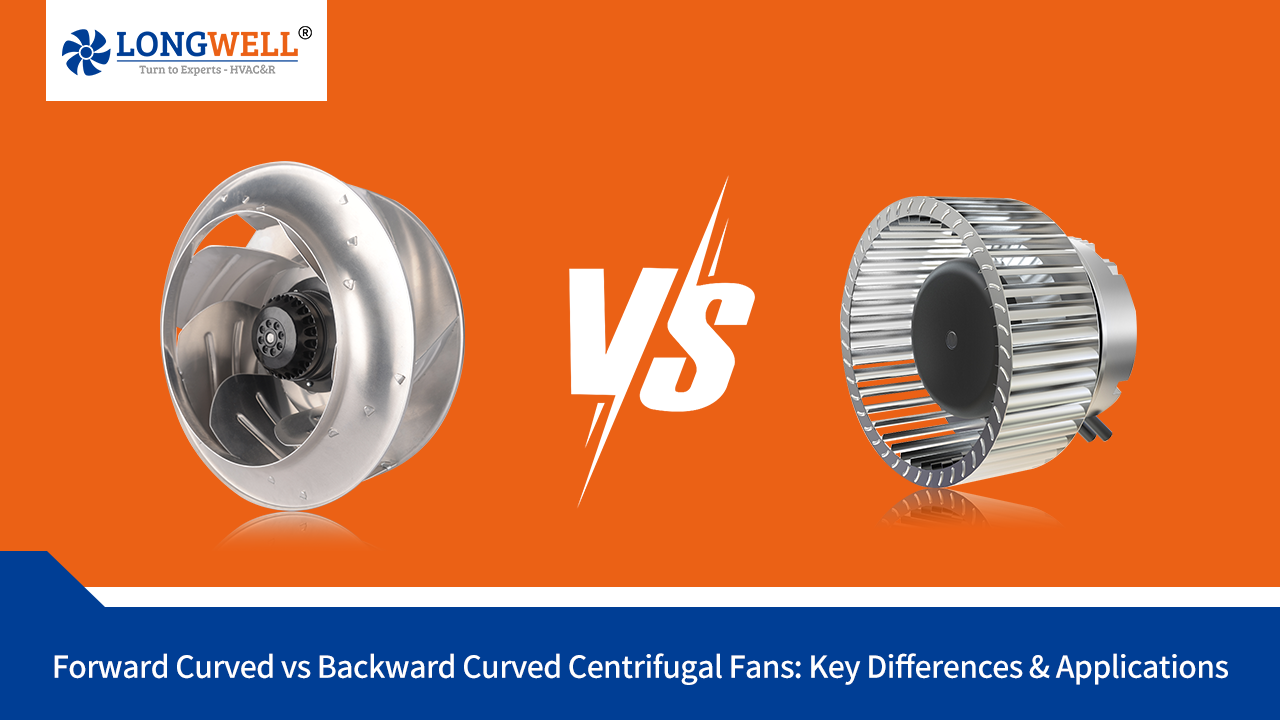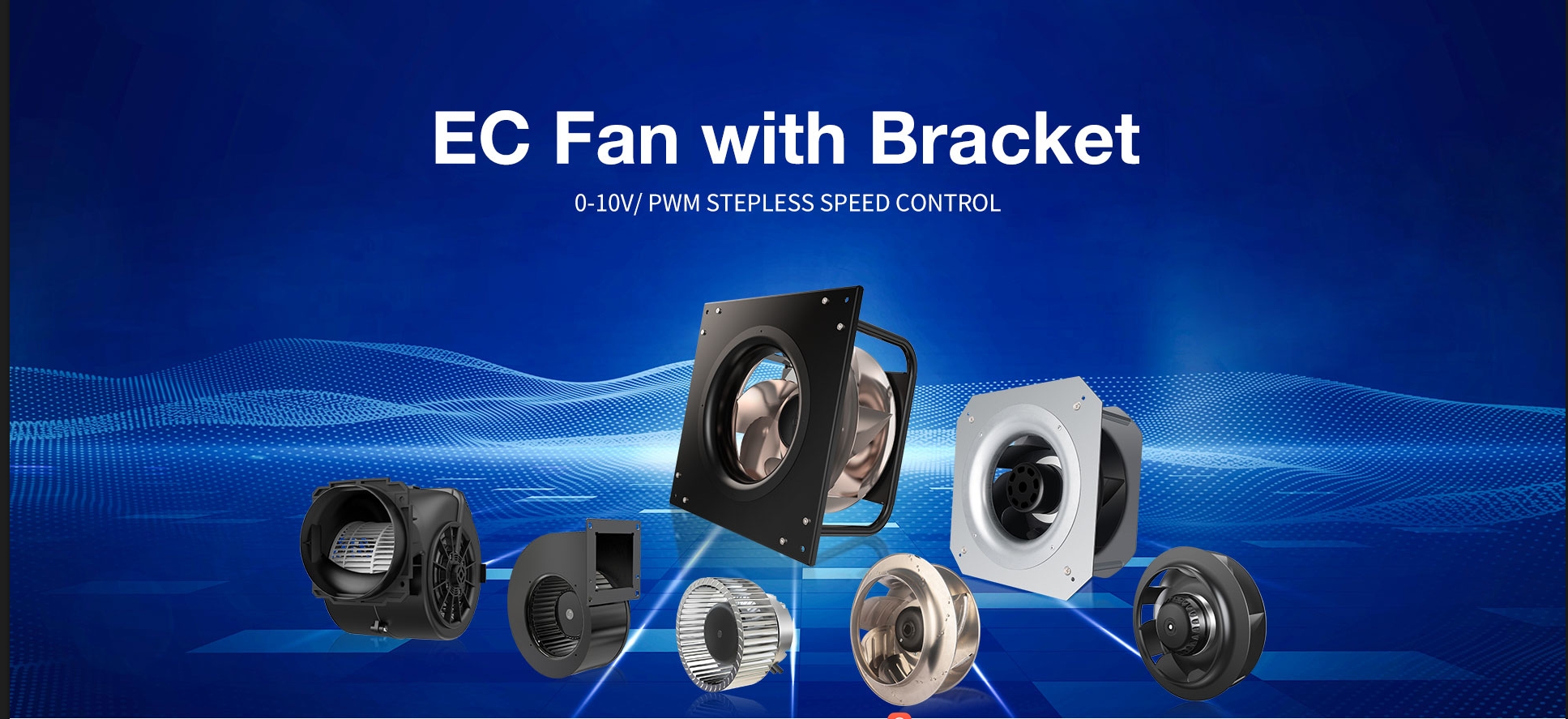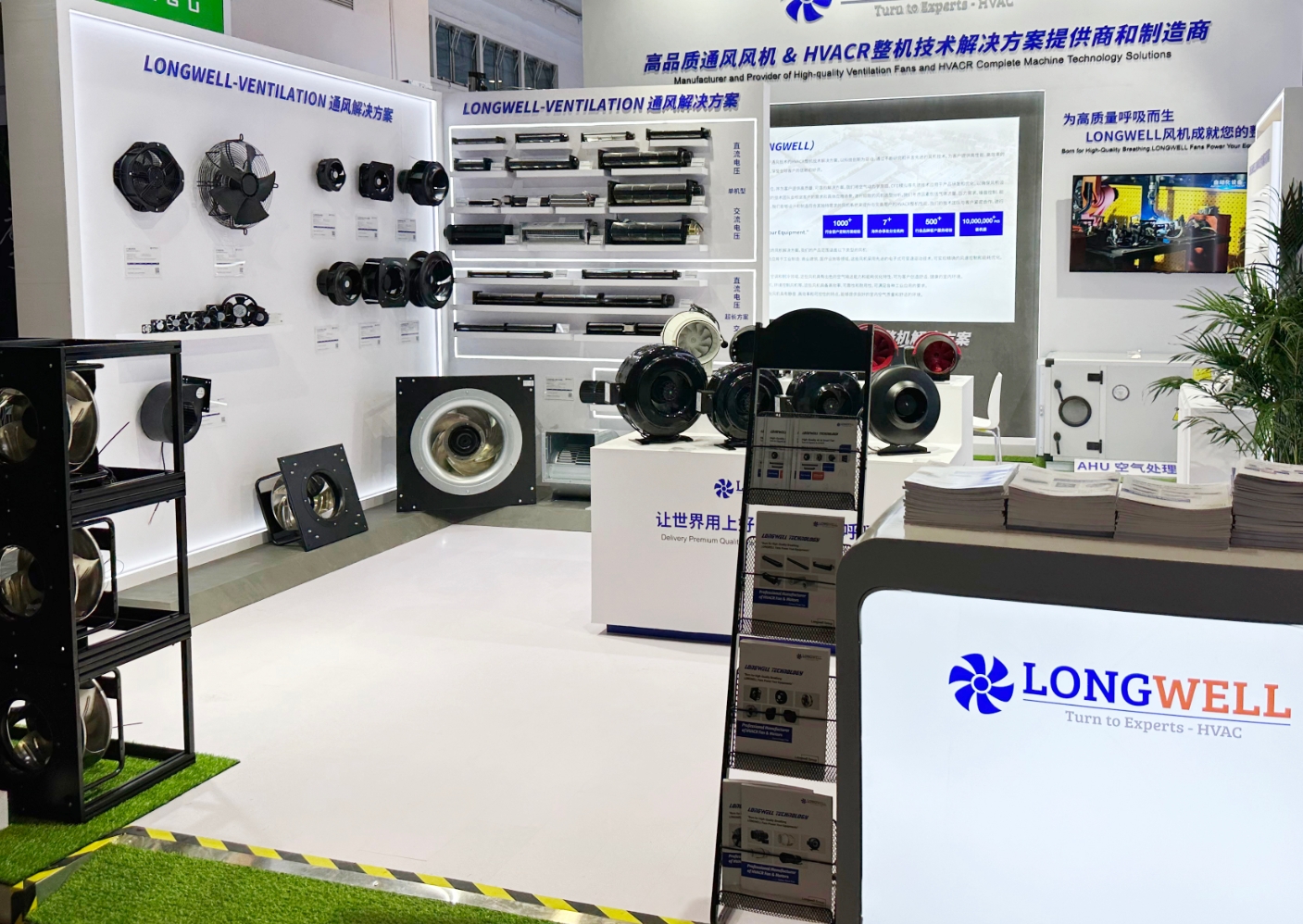Comparing Backward and Forward Curved Centrifugal Fans Key Differences Explained

You can notice differences between a backward centrifugal fan and a forward curved centrifugal fan in how they move air and use energy. LONGWELL is a trusted company for ventilation fans, offering a wide range of centrifugal fan solutions. They make each centrifugal fan to be high quality and efficient. Picking the right centrifugal fan for your space is important, as it changes how much air moves, how much energy you use, and how much it costs to run. The shape of the fan blades, called blade curvature, is very important—especially in a backward centrifugal fan—as it affects how well the fan works and how much energy it saves.
Key Takeaways
Know the blade shape differences: Backward curved fans bend away from the spin. Forward curved fans bend in the same direction as the spin. This changes how air moves and the pressure made.
Pick backward curved fans for high efficiency and strong pressure. These fans are best for factories and places that need lots of air.
Use forward curved fans for quiet and low-pressure needs. They are good for homes and small rooms. They give a steady flow of air.
Think about saving energy: Backward curved fans can cut energy costs by up to 30%. This makes them a smart choice for the future.
Always pick the fan that fits your needs. Check the airflow, pressure drop, and space you have. This helps the fan work its best.
Centrifugal Fan Types

Centrifugal fans have different blade shapes and uses. The table below shows the main types. Blade curvature affects how each fan works and where it fits best.
Type of Fan Blade | Description | Applications |
|---|---|---|
Forward Curve | Has many short blades that point with the spin, making air move in lines. | Used in home boilers, warm air heaters, fridges, and heating fan coils. |
Backward Curve | Has fewer long blades that bend away from the spin, making strong pressure. | Used in places needing high efficiency, like fume removal and heat recovery. |
Radial | Pushes air out sideways with flat blades, good for medium flow and high pressure. | Works well in dusty factories or places with gas or wet air. |
Airfoil | Made to be efficient, moves air fast through the fan. | Used in many factories that need good airflow control. |
Backward Curved Fan
A backward curved fan has fewer long blades that bend away from the spin. This shape helps the fan make strong pressure and work well in efficient systems. Many factories use this fan for jobs like removing fumes and saving heat.
Note: Backward curved fans can move lots of air, up to 300,000 CFM, and handle high pressure, even up to 40” WG. They work in hot places, up to 800°F, and come in many sizes. Makers use tough steel for the fan wheels and strong cases to keep them safe and lasting.
Forward Curved Fan
A forward curved fan has many small blades that bend with the spin. This shape makes smooth airflow and keeps noise low. You see this fan in homes and businesses, like heaters and coolers. Its small size lets it fit in tight spots.
Best for clean air jobs
Runs quietly at slow speeds
Moves air up to 4,600 CFM
Works well in places with low pressure
Pick a forward curved fan when you want quiet, steady air in a small area.
Backward Centrifugal Fan vs Forward Curved Fan
Design Differences
The biggest difference is in the blade shape. Backward centrifugal fan blades bend away from the spin. This helps the fan push air and make more pressure. Forward curved fans have many short blades. These blades curve with the spin. This shape lets the fan move lots of air but at lower pressure. The way the blades bend changes how the fan works. Always look at the blade shape before picking a fan.
Performance
How well a centrifugal fan works depends on airflow and pressure. Backward centrifugal fans are good for steady air and high pressure. They keep working even if there is more resistance. Forward curved fans move a lot of air but do not handle high pressure well. You see these fans in homes or small offices. They work best when air does not need to go far. The table below shows how each fan type works:
Fan Type | Airflow Rate | Pressure Capability |
|---|---|---|
Forward-Curved Fans | Moves lots of air at low pressure | Not good for high pressure, best for low pressure |
Backward-Curved Fans | Handles medium to high airflow | Best for high pressure, works with resistance |
Efficiency
You want a fan that saves energy and money. Backward centrifugal fans are very efficient, especially with high pressure. They use less energy to move air in tough spots. Forward curved fans work well at low pressure but lose efficiency if pressure goes up. Using an efficient fan can save up to 30% on energy in big buildings. LONGWELL makes fans that meet strict rules like ISO9001 and CE. This means you get a fan that works well for years. Efficient fans also break less, so you spend less on repairs.
Evidence Type | Description |
|---|---|
Energy Savings | Big fans can save up to 30% energy. |
Maintenance Cost Reduction | Better designs mean fewer breaks and lower costs. |
Long-term Cost Efficiency | Efficient fans lower bills and pay for themselves. |
Noise
Noise is important if you want a quiet room. Backward centrifugal fans are usually quieter. Their smooth airflow makes them good for offices, schools, or homes. Forward curved fans can be louder, especially at high speeds. Pick a backward curved fan if you want less noise and steady air. Here is a quick look at noise levels:
Backward curved fans are quieter because of smooth airflow.
They are good for quiet places like homes or offices.
Forward curved fans can be louder, so they fit busy places.
Fan Type | Noise Level (dB(A)) |
|---|---|
Forward-curved | 45 to 60 |
Backward-curved | 60 to 75 |
Cost
Cost matters when picking a centrifugal fan. Forward curved fans usually cost less to buy. They are good for simple jobs that do not need high pressure. Backward centrifugal fans may cost more at first. But they save money over time. They use less energy and need fewer repairs. LONGWELL fans last longer because they use strong parts and meet top standards. You get a fan that works well and saves money later.
Forward curved fans are cheaper for basic needs.
Backward centrifugal fans save more money over time.
LONGWELL fans give you good performance and last long.
Always pick the fan that fits your needs. Think about airflow, pressure, noise, and cost before you choose. LONGWELL has both types, so you can find the right fan for any job.
Applications

Residential
Centrifugal fans are used in many homes. They help keep the air fresh and nice. Backward curved fans work well in HVAC systems. These fans save energy and handle higher pressure. This is important for cleanrooms and even home data centers. Forward curved fans are also found in homes. They move a lot of air quietly. This makes them great for bathrooms and kitchens. Their small size lets you put them in tight places. You can use them in kitchen hoods or bathroom vents. These fans help make your home quiet and comfy.
HVAC systems help save energy
Cleanrooms need controlled air
Kitchen hoods and bathroom fans give quiet airflow
Data centers in homes need cooling
Industrial
Factories and big buildings need strong fans. Backward curved fans pull air through large systems. They help control pollution in factories. These fans work in dust collectors and scrubbers. They also help boilers get air for burning fuel. You see them in baker ovens and spray booths too. They move clean or a little dusty air. Forward curved fans are good for moving lots of air quietly. They cost less and work well in places where noise matters.
Induced draft helps big systems
Factories need pollution control
Boilers need air for burning
Plants use air-conditioning
Ovens and spray booths need airflow
LONGWELL Ventilation Fans
LONGWELL has many fans for homes and factories. You can pick impeller sizes from 280mm to 1600mm. Air volume choices go from 1,000 to 300,000 m³/h. These fans work in small offices, labs, clean rooms, and big factories. LONGWELL has sales offices all over the world. You get expert advice and help from Germany. There are special managers for big customers. LONGWELL gives 24/7 help after you buy and a 12-month warranty.
Service Aspect | Details |
|---|---|
Global Presence | Sales offices in many countries |
Expert Advice | Help with all products |
Technical Support | German engineers give support |
Key Account Management | Special managers for big customers |
After-Sale Service |
Tip: LONGWELL fans work for many jobs. They are good for quiet homes and tough factory work. You always get good help and strong products.
Choosing a Centrifugal Fan
Key Factors
When you choose a centrifugal fan, you need to match it to your space and needs. Start by looking at what your system requires. The right fan will help you save energy and keep your environment comfortable. Here are some important things to check:
Airflow rate: This tells you how much air the fan must move.
Pressure drop: This shows how much resistance the air faces in your system.
Density of air: Changes in air density can affect how your fan works.
Material to be handled: Some fans only move air, while others can handle dust or small particles.
Space constraints: The size and shape of your area may limit your fan options.
You should also think about fan blade design. The shape and curve of the blades affect how much air the fan moves and how much energy it uses. If you want the best results, always match the fan to your real needs.
Tip: LONGWELL offers expert advice and easy-to-read guides. You can talk to their team to find the best fan for your job.
Common Mistakes
Many people make mistakes when picking a fan. These errors can lead to wasted energy or even system problems. Here are some of the most common mistakes:
Choosing an oversized fan for future needs. This often leads to poor efficiency.
Not sizing the fan for your current needs. This can waste energy and money.
Ignoring how efficient the fan is at the airflow you need. This can cause performance issues.
You should also make sure the fan can handle the materials in your system. Some fans are only for air, while others can move dust or sand. Picking the wrong type can cause breakdowns or extra repairs.
Mistake | Explanation |
|---|---|
Improper sizing | The wrong size can waste energy and cause problems. |
Wrong type of fan | The wrong design can make too much noise or fail. |
Neglecting requirements | Not checking airflow or material needs can hurt performance. |
LONGWELL helps you avoid these mistakes. Their customer support gives you access to experts, 3D models, and videos. You get help choosing the right fan for your space and needs.
You can easily spot differences between backward and forward curved centrifugal fans. The table below shows their main features:
Feature | Forward Curved Fans | Backward Curved Fans |
|---|---|---|
Airflow Volume | High | Moderate |
Static Pressure | Low | High |
Noise Level | Low | Higher |
Energy Efficiency | Moderate | High |
Best For | HVAC, low-resistance | Industrial, clean rooms |
Picking the right fan is important. It helps your fan work better. You save energy and your fan lasts longer. Each fan type fits certain places best.
LONGWELL is known for its worldwide experience. They offer many fan choices and strong customer support. You can count on LONGWELL for good, efficient fans. Contact them to find the best fan for your needs.
FAQ
What is the main difference between backward and forward curved centrifugal fans?
You will notice the main difference in the blade shape. Backward curved blades bend away from the spin. Forward curved blades bend with the spin. This affects airflow, pressure, and efficiency.
Which fan type is better for saving energy?
You will save more energy with a backward curved centrifugal fan. These fans work best in high-pressure systems and use less power. You can lower your energy bills by choosing the right fan for your needs.
Can I use a forward curved fan in an industrial setting?
You can use a forward curved fan in light industrial settings. These fans work well for moving large amounts of clean air at low pressure. For heavy-duty or high-pressure jobs, you should choose a backward curved fan.
How do I know which fan size I need?
You should check your system’s airflow and pressure requirements. Measure the space and note any restrictions. You can contact LONGWELL’s experts for help. They will guide you to the best fan size for your application.
Does LONGWELL offer support after purchase?
Yes! You get 24/7 technical support and a 12-month warranty with LONGWELL ventilation fans. You can reach out anytime for help or advice.
See Also
Comparing Backward And Forward Curved Fans For Performance
A Comprehensive Overview Of Forward Curved Fans In HVAC
Understanding The Performance Features Of Centrifugal Fans
Durability Comparison: Centrifugal Fans Against Axial Fans
Exploring Longwell Centrifugal Fans' Energy Efficiency Achievements